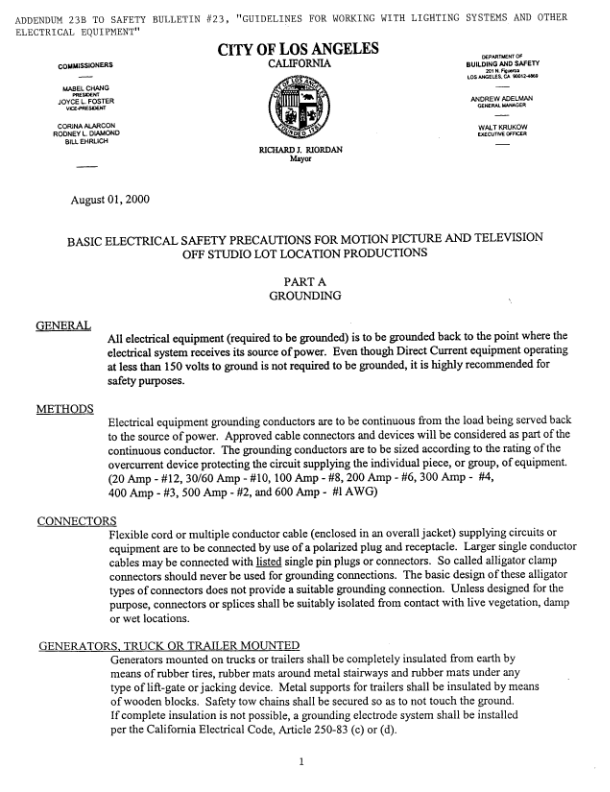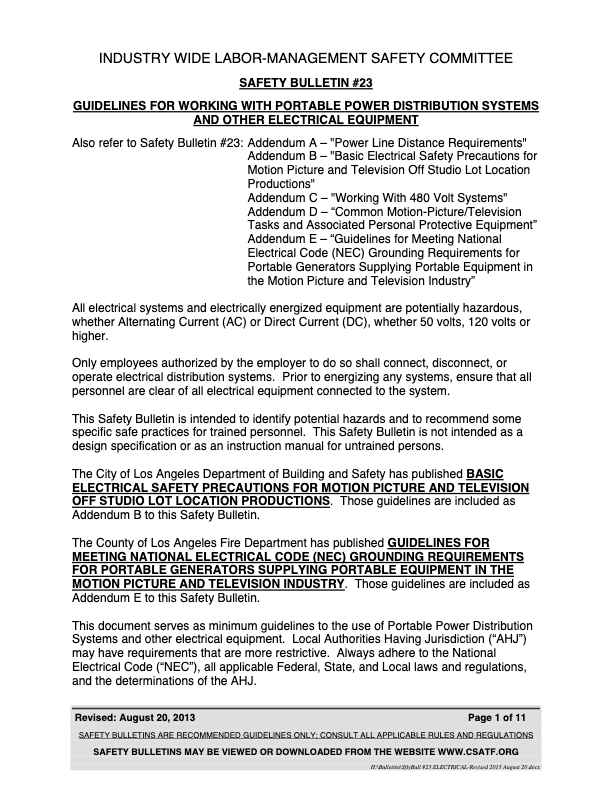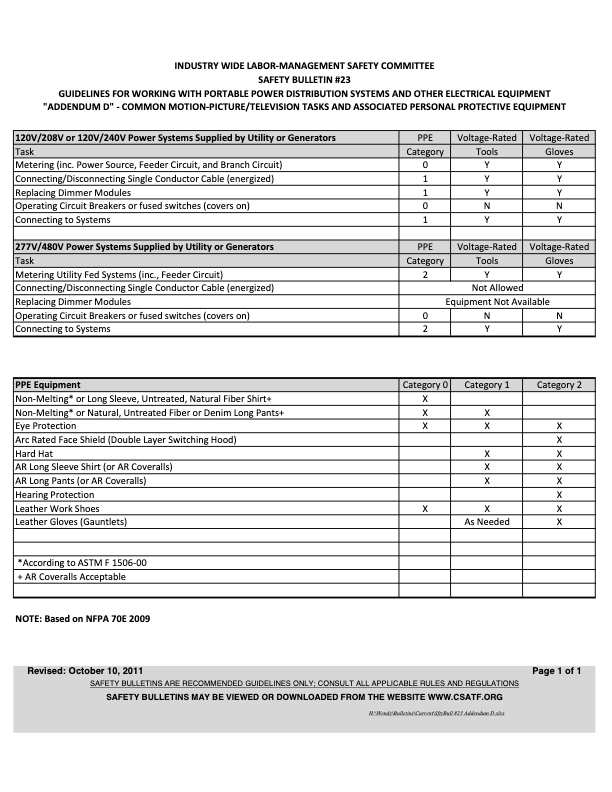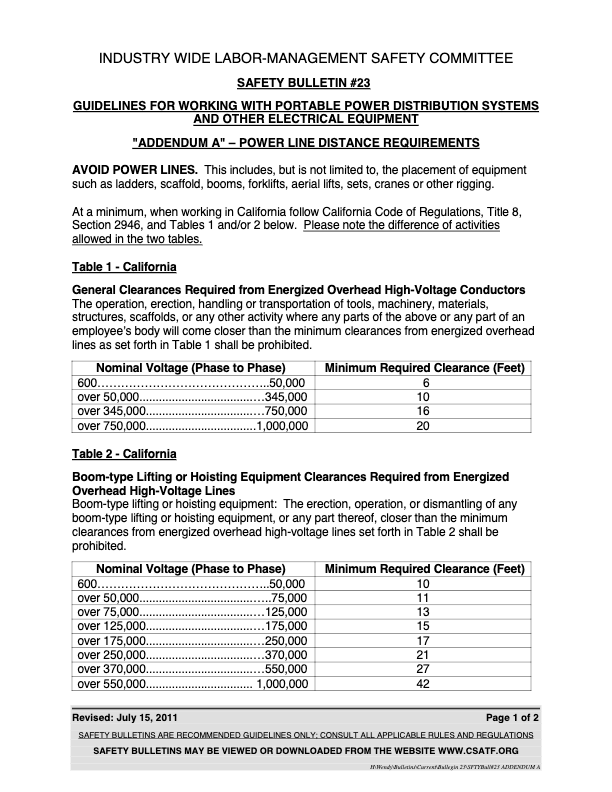Safety Bulletin
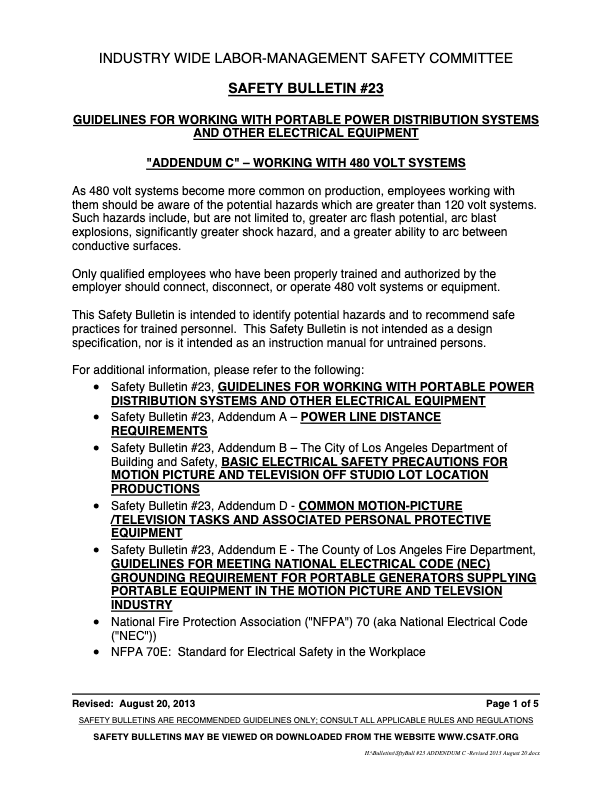
Guidelines
As 480 volt systems become more common on production, employees working with them should be aware of the potential hazards which are greater than 120 volt systems. Such hazards include, but are not limited to, greater arc flash potential, arc blast explosions, significantly greater shock hazard, and a greater ability to arc between conductive surfaces.
Only qualified employees who have been properly trained and authorized by the employer should connect, disconnect, or operate 480 volt systems or equipment.
This Safety Bulletin is intended to identify potential hazards and to recommend safe practices for trained personnel. This Safety Bulletin is not intended as a design specification, nor is it intended as an instruction manual for untrained persons.
Identifying Source Voltage for Cord and Plug Connected Devices
Distribution board, panel board and disconnect switch enclosures can only be opened by qualified and designated person(s). Prior to connecting onto or energizing any 480 volt system, the source voltage must be identified and verified. Proper and safe meter techniques must be observed to prevent arcing. An appropriately rated voltage meter must be used. Employees using test equipment on 480 volt systems shall receive proper training prior to metering the source power.
Color Coding for Voltage and Phase Identification
Portable cables and conductors MUST be color coded to ensure that 120 volt equipment is not mistakenly connected to a 480 volt system.
Neutral conductors shall be identified by marking at least the first 6 inches from both ends of each length of conductor with GRAY (white is to be used for 120 volt neutral conductors).
Grounding conductors shall be identified by marking at least the first 6 inches from both ends of each length of conductor with GREEN or GREEN WITH YELLOW STRIPES.
Phase conductors (hots) shall be identified by marking at least the first 6 inches from both ends of each length of conductor with BROWN, ORANGE or BRIGHT YELLOW tape.
Where more than one voltage system exists within the same location, each system shall be identified by voltage and system. This can be done by additional color coding, marking tape, tagging, or other equally effective means.
Where color coding is used to distinguish between different lengths or owners of cable, it must be done so that there is no confusion created.
To avoid confusion between different nominal voltage systems, YELLOW SHOULD NOT BE USED IN PORTABLE 120 VOLT SYSTEMS.
Grounding Procedures
All 480 volt systems shall be grounded in accordance with NEC Article 250 and additional requirements, if any, of the Authority Having Jurisdiction (“AHJ”).
Special attention should be taken when using multiple power sources whose energized systems may come into contact with each other. Ensure systems are bonded together with the appropriately sized bonding jumper and connected to a common grounding electrode to ensure that no potential exists between the system grounds.
If grounding rods are required, use proper sized grounding rods and connectors as per the NEC.
Before driving grounding rods into the earth, an underground service company should be contacted to make sure the area is clear of hidden hazards such as water pipes, gas lines, buried cable, and other obstructions.
Grounding conductors from portable 480 volt sources used in buildings should be connected to the grounding connection at the service entrance or main power source.
Devices and Cables
All cable shall be listed for its intended use by an approved testing laboratory.
Dual jacketed type “W” or equivalent cable is recommended for single conductor feeder cables on 480 volt power systems since small punctures and fractures in the insulation may not be seen during visual inspection.
Single conductor connectors used on “hots” and “neutrals” shall be connected to the conductors by means of solder, set-screw, or crimping. Equipment grounding conductor connection devices or fittings that depend solely on solder shall not be used. Single conductor connectors shall be of the single pole and locking type.
Spider boxes, splicing blocks, and other distribution equipment shall be rated and identified for use on 480 volt systems in conformity with the provisions of the NEC. When more than one voltage system is used on the same premises, the equipment shall be marked in a suitable manner to identify the system to which they are connected.
Cables and devices must be protected from foot and automobile traffic. When using elevated truss crossovers, the metal structure must be grounded to the source ground.
When 480 volt equipment is mounted, suspended, or otherwise attached to any structure which uses metal in its construction (e.g., scaffold, truss, greenbeds, or pipe grids), the metal components of the structure must be grounded to the source ground.
480 volt systems should be elevated and/or protected in such a manner to avoid contact with water.
When 480 volt systems may be used in or around water, such systems shall be designed and listed for use in water or wet conditions (e.g., NEMA 3R enclosures, GFCI devices).
Plugging and Unplugging Electrical Equipment
Visually inspect the condition of the plug, cable, and equipment for any signs of excess wear, loose parts, frayed cables, cracked/punctured insulation, pinched/crushed outer
jacket, exposed current-carrying parts or any other signs of damage. DO NOT USE equipment in any of these conditions. Label and return this equipment for repair.
All grounded equipment should be tested for continuity between the ground pin on the plug and the metal parts of the lighting equipment before it is placed into service.
Turn off the power when connecting to, or disconnecting from, 480 volt systems. When branching off an energized system, shut off the power and lock-out/tag-out all switches that may energize the circuit being worked on. All equipment that is being plugged and unplugged shall be in the off position to avoid creating an arc at the receptacle. Verify with the appropriate meter that the power is turned off. Proper Personal Protection Equipment (PPE), including protective gloves and clothing, shall be worn to avoid getting burned from a flash created by a short-circuit in the equipment.
Connecting Order of Single Conductors
All single conductor connections shall be made in the following order:
- Grounds
- Neutrals
- Hots
Disconnect in the reverse order:
- Hots
- Neutrals
- Grounds
All multi-pole connectors shall provide for “first make, last break” of the ground pole.
Guarding of Live or Non-Insulated Parts
Any part that is live or non-insulated must be covered with appropriate insulation material or protected or barricaded to prevent accidental contact by persons or objects.
Emergency Response
Electrical accidents are very serious and care must be taken to ensure that potential rescuers do not become victims. If an electrical accident occurs, follow proper emergency procedures and have Emergency Medical Services (“EMS”) contacted immediately. do not approach any electrical accident until you have been notified by qualified personnel that it is safe to approach.
Properly secure the accident area to prevent the possibility of additional victims.
Do not touch a victim of electrical shock while he or she is connected to the circuit. If safe to do so, turn off the power.
While waiting for EMS to arrive, and if trained, follow proper procedures for Cardiopulmonary Resuscitation (“CPR”), including the use of an Automated External Defibrillator (“AED”), if available.
Since the possible effects of electrical shock can manifest hours after the event, any victim of electrical shock must be evaluated by a qualified medical professional.

